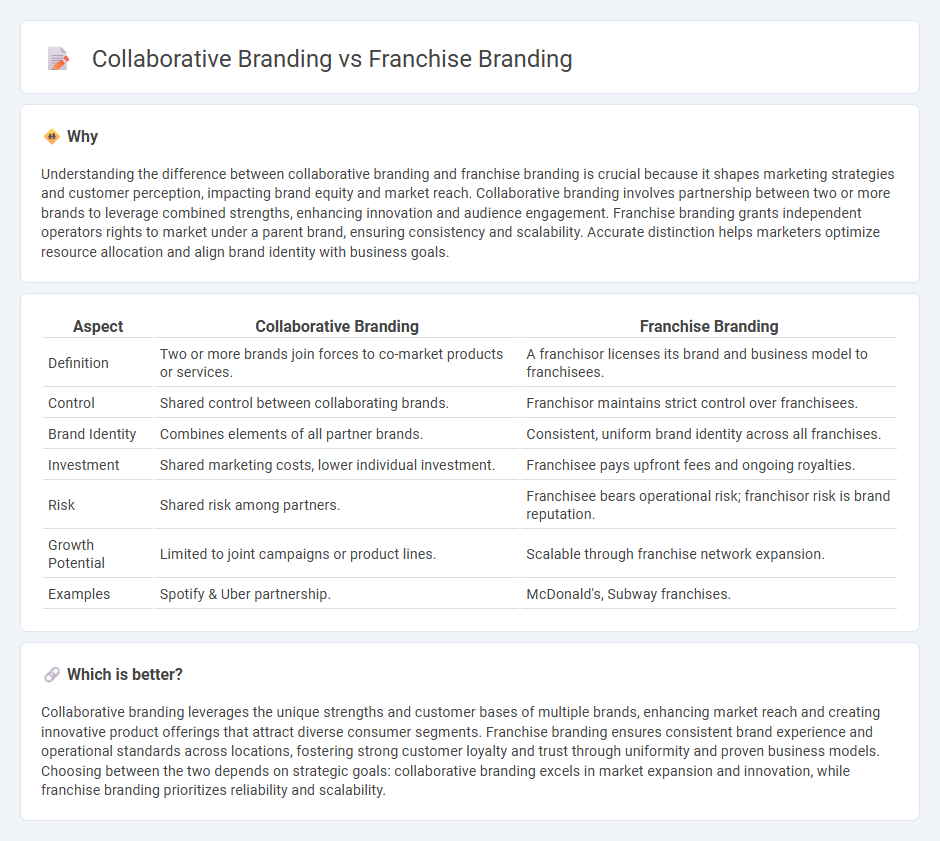
Collaborative branding merges the strengths of two or more brands to create a unified market presence, enhancing customer reach and shared value. Franchise branding involves a franchisor granting rights to a franchisee to operate under its brand, ensuring consistency and leveraging established brand equity across locations. Discover more about the strategic benefits and applications of these branding approaches.
Why it is important
Understanding the difference between collaborative branding and franchise branding is crucial because it shapes marketing strategies and customer perception, impacting brand equity and market reach. Collaborative branding involves partnership between two or more brands to leverage combined strengths, enhancing innovation and audience engagement. Franchise branding grants independent operators rights to market under a parent brand, ensuring consistency and scalability. Accurate distinction helps marketers optimize resource allocation and align brand identity with business goals.
Comparison Table
| Aspect | Collaborative Branding | Franchise Branding |
|---|---|---|
| Definition | Two or more brands join forces to co-market products or services. | A franchisor licenses its brand and business model to franchisees. |
| Control | Shared control between collaborating brands. | Franchisor maintains strict control over franchisees. |
| Brand Identity | Combines elements of all partner brands. | Consistent, uniform brand identity across all franchises. |
| Investment | Shared marketing costs, lower individual investment. | Franchisee pays upfront fees and ongoing royalties. |
| Risk | Shared risk among partners. | Franchisee bears operational risk; franchisor risk is brand reputation. |
| Growth Potential | Limited to joint campaigns or product lines. | Scalable through franchise network expansion. |
| Examples | Spotify & Uber partnership. | McDonald's, Subway franchises. |
Which is better?
Collaborative branding leverages the unique strengths and customer bases of multiple brands, enhancing market reach and creating innovative product offerings that attract diverse consumer segments. Franchise branding ensures consistent brand experience and operational standards across locations, fostering strong customer loyalty and trust through uniformity and proven business models. Choosing between the two depends on strategic goals: collaborative branding excels in market expansion and innovation, while franchise branding prioritizes reliability and scalability.
Connection
Collaborative branding and franchise branding both leverage partnerships to enhance market reach and brand value by combining the strengths of multiple entities. Collaborative branding unites distinct brands to co-create products or campaigns, while franchise branding extends a brand's identity through licensed operators maintaining consistency. Together, they reinforce brand equity by fostering consumer trust and expanding customer bases across different markets.
Key Terms
Brand Consistency
Franchise branding ensures strict adherence to brand guidelines across all locations, maintaining uniformity in logo usage, color schemes, and messaging to deliver a consistent customer experience. Collaborative branding involves multiple brands joining forces, requiring careful coordination to blend distinct identities while preserving core brand elements. Explore strategies to balance brand consistency and flexibility in collaborative branding efforts.
Co-Branding
Franchise branding establishes a consistent identity across multiple locations under a single brand, ensuring uniform customer experience and brand loyalty. Collaborative branding, particularly co-branding, involves two or more brands partnering to create joint marketing efforts or products, leveraging the strengths and customer bases of each partner to enhance market presence. Explore the nuances of franchise and collaborative branding to fully understand the strategic advantages of co-branding in today's competitive market.
Brand Autonomy
Franchise branding maintains strict brand autonomy by enforcing consistent brand guidelines and operational standards across all locations, ensuring uniform customer experience and brand identity. Collaborative branding, on the other hand, involves shared brand control with partners, allowing flexibility and co-creation but potentially diluting individual brand autonomy. Explore how brand autonomy impacts the success of these strategies in diverse market environments.
Source and External Links
Franchise Marketing Strategies: How to Achieve Brand Consistency Across Your Franchise Network - This article discusses the importance of brand consistency across a franchise network, highlighting the benefits of leveraging an established brand identity to accelerate business success.
How to Create a Franchise Branding Checklist - This checklist provides steps to ensure consistent branding across all franchise locations, including identifying mission statements, core values, and target customers.
Why Is Branding an Important Part of a Successful Franchise - Strong branding is essential for a franchise's success, as it builds trust and loyalty among customers, attracts more customers, and increases franchisee attraction.
 dowidth.com
dowidth.com